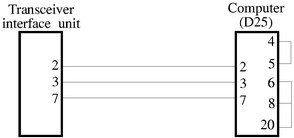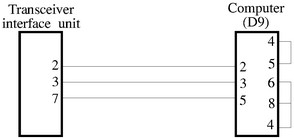General Remarks:
CAT operation requires a data exchange between transceiver and PC. Thus, a suitable cable connection between both devices has to be provided. The type of cable to be used along with other hard-/software components depends on the following cases:
1. Classical connection.
If the TRX provides a RS232 interface socket and the PC still is equipped with the same type of connector things are very easy. A simple RS232 cable is required and to be connected as outlined in the paragraph on Connecting your Transceiver.
2. TRX has RS232 socket, PC only provides USB serial interface(s).
This case requires suitable cabling (one RS232 cable, one USB cable) plus a RS232/USB converter box. In addition to these components a software driver must be available in order to run the converter under WINDOWS. In most cases WINDOWS will recognize the converter device automatically as soon as it is connected to the PC's USB port and install a suitable driver. Only in case the device was not recognized a driver will have to be installed manually. The manufacturer of the converter should provide this piece of software.
The driver will create a serial COM-port which can be inspected by means of WINDOWS's device manager. It is important to note the COM-port number assigned to it. The COM-port number will be needed for setting up the CAT configuration in TurboLog 4 ( see below ).
3 USB ports on both, TRX and PC:
Only a suitable USB cable will be required in order to connect both devices. Either WINDOWS automatically recognizes the TRX when it is connected or a driver has to be installed manually. It has to be provided by the TRX's manufacturer.
As above: The driver will create a serial COM-port which can be inspected by means of WINDOWS's device manager. It is important to note the COM-port number assigned to it. The COM-port number will be needed for setting up the CAT configuration in TurboLog 4 ( see below ).
Historical Case:
All transceivers supporting computer control do so via an external interface unit, whose primary purpose is to provide level conversion and isolation or via a built-in true RS-232 interface. The level converting interface unit plugs into the back of your transceiver, and then a lead goes from a serial port on your computer to the interface unit.
You can connect your transceiver via the interface unit to any port that is capable of supporting interrupt handling. This means the port must have a unique IRQ. In most PCs, COM 1 and 2 will work fine, but often the COM3 and/or COM 4 ports, if fitted either do not have, or share an IRQ line. Such ports cannot be used for the transceiver interface, but could be used for the Morse code keyer output, for example.
Your interface unit to computer cables should be a straight through type, as follows:

TNC and Transceiver interface cables for a 25 pin plug

TNC and Transceiver interface cables for a 9 pin plug
Please note, however, as a net result TxD and RxD need to be crossed. This is performed in most cases by the interface unit, e.g. IF-232C from KENWOOD. If hardware handshake is to be activated by connecting RTS and CTS on both sides (transceiver and PC) these wires need to be crossed as well....at least as a net result with respect to the interface unit.
This means: An output/transmitting pin on one side of the serial interface must always see an input/receiving pin on the other side. The wiring has to be performed accordingly.
This topic was last edited on Thursday, 12-Dec-2024, at 13:30